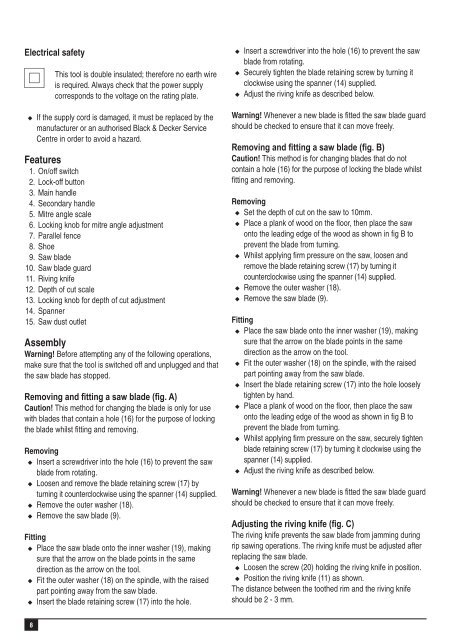BlackandDecker Scie Circulaire- Cd602 - Type 2 - Instruction Manual (Anglaise)
BlackandDecker Scie Circulaire- Cd602 - Type 2 - Instruction Manual (Anglaise)
BlackandDecker Scie Circulaire- Cd602 - Type 2 - Instruction Manual (Anglaise)
Create successful ePaper yourself
Turn your PDF publications into a flip-book with our unique Google optimized e-Paper software.
Electrical safety<br />
#<br />
This tool is double insulated; therefore no earth wire<br />
is required. Always check that the power supply<br />
corresponds to the voltage on the rating plate.<br />
u If the supply cord is damaged, it must be replaced by the<br />
manufacturer or an authorised Black & Decker Service<br />
Centre in order to avoid a hazard.<br />
Features<br />
1. On/off switch<br />
2. Lock-off button<br />
3. Main handle<br />
4. Secondary handle<br />
5. Mitre angle scale<br />
6. Locking knob for mitre angle adjustment<br />
7. Parallel fence<br />
8. Shoe<br />
9. Saw blade<br />
10. Saw blade guard<br />
11. Riving knife<br />
12. Depth of cut scale<br />
13. Locking knob for depth of cut adjustment<br />
14. Spanner<br />
15. Saw dust outlet<br />
Assembly<br />
Warning! Before attempting any of the following operations,<br />
make sure that the tool is switched off and unplugged and that<br />
the saw blade has stopped.<br />
Removing and fitting a saw blade (fig. A)<br />
Caution! This method for changing the blade is only for use<br />
with blades that contain a hole (16) for the purpose of locking<br />
the blade whilst fitting and removing.<br />
Removing<br />
u Insert a screwdriver into the hole (16) to prevent the saw<br />
blade from rotating.<br />
u Loosen and remove the blade retaining screw (17) by<br />
turning it counterclockwise using the spanner (14) supplied.<br />
u Remove the outer washer (18).<br />
u Remove the saw blade (9).<br />
Fitting<br />
u Place the saw blade onto the inner washer (19), making<br />
sure that the arrow on the blade points in the same<br />
direction as the arrow on the tool.<br />
u Fit the outer washer (18) on the spindle, with the raised<br />
part pointing away from the saw blade.<br />
u Insert the blade retaining screw (17) into the hole.<br />
u Insert a screwdriver into the hole (16) to prevent the saw<br />
blade from rotating.<br />
u Securely tighten the blade retaining screw by turning it<br />
clockwise using the spanner (14) supplied.<br />
u Adjust the riving knife as described below.<br />
Warning! Whenever a new blade is fitted the saw blade guard<br />
should be checked to ensure that it can move freely.<br />
Removing and fitting a saw blade (fig. B)<br />
Caution! This method is for changing blades that do not<br />
contain a hole (16) for the purpose of locking the blade whilst<br />
fitting and removing.<br />
Removing<br />
u Set the depth of cut on the saw to 10mm.<br />
u Place a plank of wood on the floor, then place the saw<br />
onto the leading edge of the wood as shown in fig B to<br />
prevent the blade from turning.<br />
u Whilst applying firm pressure on the saw, loosen and<br />
remove the blade retaining screw (17) by turning it<br />
counterclockwise using the spanner (14) supplied.<br />
u Remove the outer washer (18).<br />
u Remove the saw blade (9).<br />
Fitting<br />
u Place the saw blade onto the inner washer (19), making<br />
sure that the arrow on the blade points in the same<br />
direction as the arrow on the tool.<br />
u Fit the outer washer (18) on the spindle, with the raised<br />
part pointing away from the saw blade.<br />
u Insert the blade retaining screw (17) into the hole loosely<br />
tighten by hand.<br />
u Place a plank of wood on the floor, then place the saw<br />
onto the leading edge of the wood as shown in fig B to<br />
prevent the blade from turning.<br />
u Whilst applying firm pressure on the saw, securely tighten<br />
blade retaining screw (17) by turning it clockwise using the<br />
spanner (14) supplied.<br />
u Adjust the riving knife as described below.<br />
Warning! Whenever a new blade is fitted the saw blade guard<br />
should be checked to ensure that it can move freely.<br />
Adjusting the riving knife (fig. C)<br />
The riving knife prevents the saw blade from jamming during<br />
rip sawing operations. The riving knife must be adjusted after<br />
replacing the saw blade.<br />
u Loosen the screw (20) holding the riving knife in position.<br />
u Position the riving knife (11) as shown.<br />
The distance between the toothed rim and the riving knife<br />
should be 2 - 3 mm.<br />
8
















